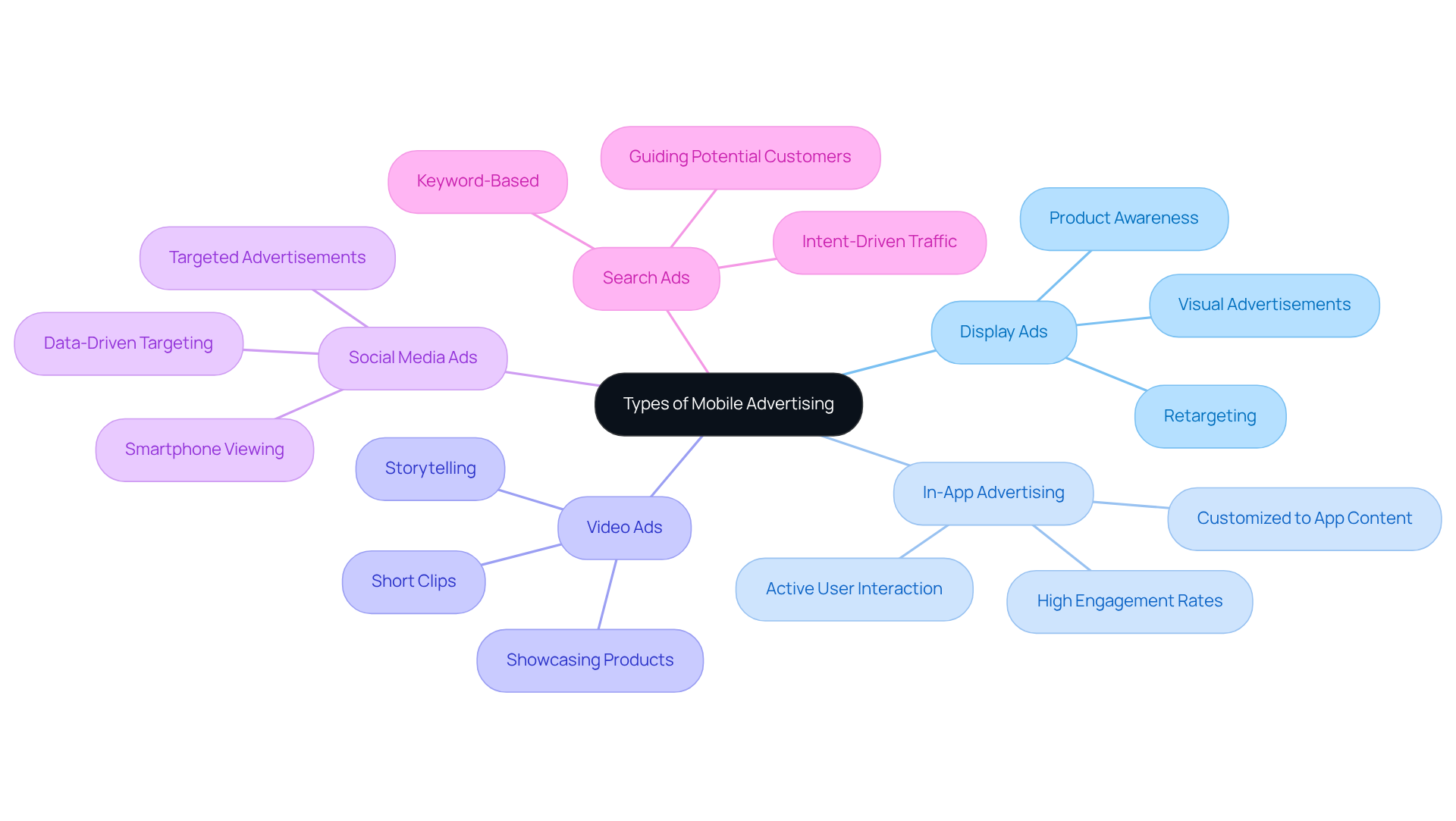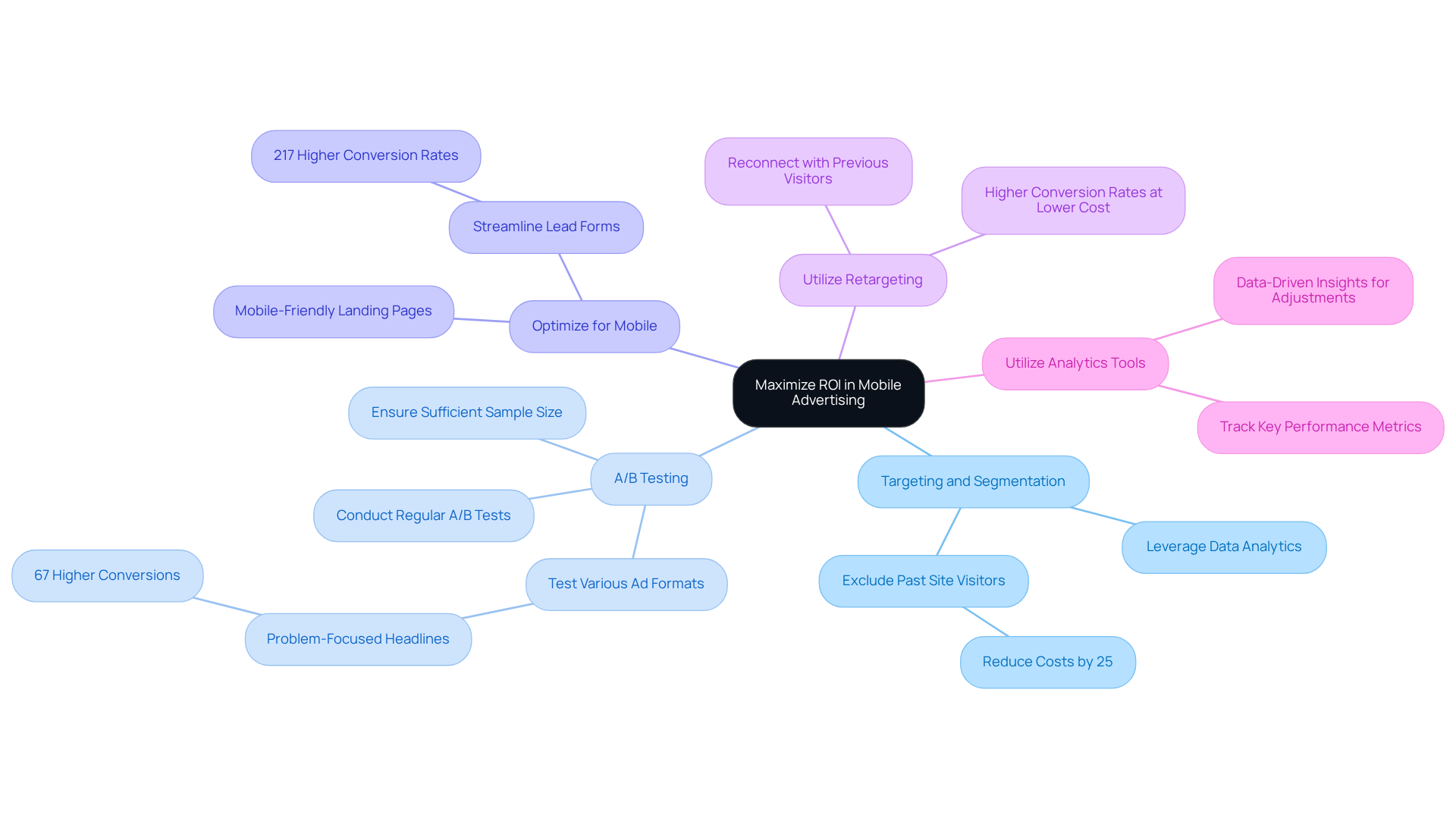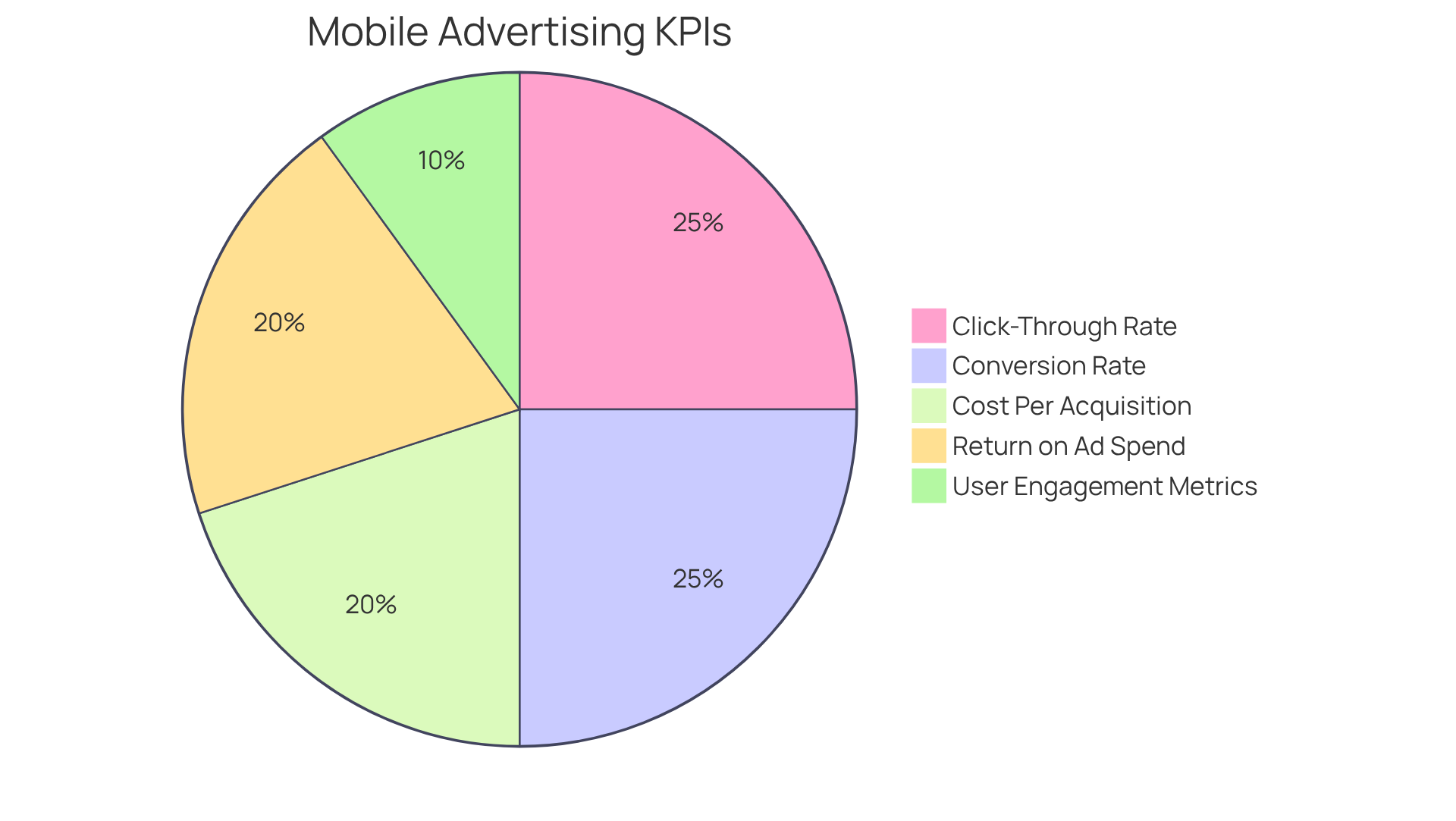
Overview
Mobile advertising is crucial for DTC brands, significantly boosting visibility and engagement. This, in turn, leads to higher conversions and enhanced customer loyalty. Various mobile ad formats play a pivotal role in this process. By employing effective strategies to maximize ROI, brands can leverage the full potential of mobile advertising. Furthermore, analytics are indispensable for measuring campaign success, providing insights that underscore the critical role of mobile advertising in today’s e-commerce landscape.
To illustrate, consider the diverse mobile ad formats available. From in-app advertisements to social media promotions, each format offers unique advantages that can be tailored to specific audiences. By understanding these options, brands can create targeted campaigns that resonate with consumers.
Moreover, implementing effective strategies is essential. Brands must focus on optimizing their ad spend and utilizing data-driven insights to refine their approaches. This not only enhances ROI but also fosters a deeper connection with customers, driving loyalty and repeat business.
Analytics serve as the backbone of successful mobile advertising campaigns. By continuously measuring performance and adjusting strategies accordingly, brands can ensure they remain competitive in a rapidly evolving market. This analytical approach not only highlights successes but also identifies areas for improvement, reinforcing the importance of mobile advertising in achieving business objectives.
In conclusion, mobile advertising is not just an option; it is a necessity for DTC brands aiming to thrive in the digital marketplace. By embracing mobile ad formats, implementing effective strategies, and leveraging analytics, brands can significantly enhance their visibility, engagement, and ultimately, their bottom line.
Introduction
The surge in mobile device usage has fundamentally transformed the advertising landscape, compelling direct-to-consumer (DTC) brands to adapt their strategies. With over half of e-commerce visits now originating from smartphones, the potential for mobile advertising to enhance engagement and drive conversions is staggering. Yet, the challenge lies in navigating the vast array of advertising formats and techniques available to ensure maximum return on investment.
What best practices can elevate mobile advertising efforts to new heights? How can DTC brands effectively measure their success in this dynamic environment? These questions are crucial as brands seek to harness the power of mobile advertising. By understanding the landscape and implementing strategic approaches, DTC brands can not only keep pace but thrive in this rapidly evolving market.
Define Mobile Advertising and Its Importance for DTC Brands
Promotional messaging is a critical practice for DTC companies, involving the strategic communication of the advertisement of mobile marketing messages to users on their handheld devices, such as smartphones and tablets. With the increasing reliance on smartphones for shopping and exploration, the advertisement of mobile has become essential. In fact, data shows that over 50% of e-commerce visits now originate from handheld devices. This statistic underscores the necessity for companies to refine their marketing strategies tailored to this platform.
The advertisement of mobile through effective portable promotions not only enhances visibility but also significantly boosts engagement rates, leading to higher conversions and increased customer loyalty. By leveraging the advertisement of mobile promotions, DTC companies can connect more effectively with their target audience, ensuring that their marketing initiatives align with consumer behavior patterns.
Partnering with an expert agency like Parah Group can amplify these efforts. Parah Group distinguishes itself from other CRO agencies by emphasizing profitability and sustainable growth. Their focus on strategies that minimize costs while maximizing margins ensures that on-the-go promotional campaigns are not only captivating but also designed to convert, optimizing the return on investment for DTC brands.
Implementing Parah Group's CRO strategies can facilitate data-driven decisions that foster business growth, lower customer acquisition costs, and enhance overall profitability. This approach not only positions DTC companies for success but also reinforces their market presence in an increasingly competitive landscape.

Explore Types of Mobile Advertising: Formats and Their Applications
Mobile advertising encompasses various formats, each with distinct applications that can significantly enhance engagement and ROI for DTC brands:
-
Display Ads: These visual advertisements, whether static or animated, appear on applications and websites. They are particularly effective for product awareness and retargeting, enabling businesses to reconnect with potential customers who have previously engaged with their offerings.
-
In-App Advertising: Ads shown within applications are customized to the app's content, leading to high engagement rates. This format capitalizes on the individual's active interaction with the app, making it an ideal choice for brands looking to connect with their audience in a meaningful way.
-
Video Ads: Short video clips integrated into social media feeds or streaming platforms serve as powerful tools for storytelling and showcasing products in action. With the rise of portable video consumption, these ads can capture attention quickly and convey messages effectively.
-
Social Media Ads: Targeted advertisements on platforms such as Instagram and Facebook are tailored for smartphone viewing and utilize data to reach specific demographics. This precision in targeting can lead to higher engagement rates and conversion potential.
-
Search Ads: These ads appear in search engine results when users search for relevant keywords on their mobile devices. By capturing intent-driven traffic, search ads can effectively guide potential customers to a company's offerings at the moment they are most interested.
Understanding these formats allows DTC brands to select the most suitable options for their campaigns, ensuring they engage their audience effectively. For instance, QuikTrip's innovative in-game promotion campaign successfully reached over three million engaged gamers, achieving a remarkable 98 percent viewability rate. This underscores the significance of strategic placements of the advertisement of mobile and audience targeting in maximizing the impact of portable promotions.

Implement Strategies to Maximize ROI in Mobile Advertising Campaigns
To maximize ROI in mobile advertising campaigns, DTC brands must implement effective strategies that drive results:
-
Targeting and Segmentation: Leverage data analytics to segment your audience based on behavior, preferences, and demographics. Tailored messaging significantly enhances relevance and engagement, leading to improved performance. For instance, excluding past site visitors from awareness campaigns can reduce costs by up to 25% without affecting conversion rates, reinforcing the importance of precise targeting.
-
A/B Testing: Regularly conduct A/B tests on various ad formats, messages, and visuals to identify what resonates most with your audience. This iterative approach is essential; a structured testing protocol ensures reliable results. A/B testing must involve a sufficient number of participants and operate for a minimum of one week to ensure dependable results. For example, a cleaning company found that a specific problem-focused headline outperformed a generic one by 67%, reducing their cost per lead from $45 to $27. Such insights can refine campaigns for optimal performance, aligning with the holistic approach of Conversion Rate Optimization (CRO) that emphasizes rigorous testing to maximize existing resources and ensure that paid ads and landing pages are seamlessly aligned.
-
Optimize for Mobile: Ensure that landing pages and websites are mobile-friendly. A smooth customer experience is essential; streamlining lead forms can enhance conversion rates considerably, as evidenced by a test indicating that a simplified form surpassed a more complicated one by 217%. This emphasis on client experience is a key aspect of effective CRO strategies.
-
Utilize Retargeting: Apply retargeting techniques to reconnect with individuals who have previously engaged with your business but did not convert. This approach can lead to higher conversion rates at a lower cost, as it focuses on users already familiar with your offerings. Retargeting is a powerful tool in the CRO arsenal, driving significant growth by maximizing the potential of existing traffic.
-
Utilize Analytics Tools: Employ robust analytics tools to track key performance metrics such as click-through rates, conversion rates, and customer acquisition costs. Data-driven insights are vital for making informed adjustments to campaigns, ensuring that resources are allocated effectively. This analytical method is essential for sustainable growth and profitability in DTC companies.
By adopting these strategies, DTC companies can significantly enhance their effectiveness in the advertisement of mobile, ultimately leading to improved ROI and sustained growth through the long-term benefits of CRO.

Measure Success and Optimize Mobile Advertising Efforts
To measure success in mobile advertising effectively, DTC brands must prioritize key performance indicators (KPIs) that drive results:
-
Click-Through Rate (CTR): This metric reveals the proportion of individuals who clicked on your ad compared to those who viewed it. A higher CTR indicates that your ad resonates well with the audience, showcasing effective targeting and creative execution.
-
Conversion Rate: This measures the percentage of users who take a desired action after clicking on your ad, such as making a purchase or signing up for a newsletter. It serves as a direct indicator of your campaign's effectiveness in fostering meaningful interactions.
-
Cost Per Acquisition (CPA): This metric determines the total expense incurred to acquire a customer through mobile promotion. Understanding the advertisement of mobile is crucial for assessing the profitability of your campaigns and ensuring sustainable growth.
-
Return on Ad Spend (ROAS): ROAS evaluates the revenue generated for every dollar spent on advertising. A higher ROAS signifies a more effective campaign, enabling brands to allocate budgets more strategically.
-
User Engagement Metrics: Track metrics such as time spent on site, pages per session, and bounce rates to assess user engagement and overall experience. High engagement often correlates with better conversion rates and customer satisfaction.
Moreover, consider that 42% of all purchases from smartphones arise from social media and e-commerce sites, underscoring the significant impact of these platforms on buying choices. By continuously monitoring these KPIs, DTC brands can pinpoint areas for improvement, refine their advertising strategies, and ultimately enhance their return on investment (ROI). As emphasized by Partow Ads, KPIs are the lifeblood of campaign success, guiding marketers toward their objectives and providing invaluable insights into the effectiveness of their campaigns. With 52% of all PPC clicks coming from mobile devices, the advertisement of mobile is essential for optimizing these metrics and maintaining competitiveness in the evolving digital landscape.

Conclusion
Mobile advertising has become a crucial element of marketing strategies for direct-to-consumer (DTC) brands, fueled by the growing dependence on smartphones for shopping. By effectively harnessing mobile platforms, businesses can boost visibility, drive engagement, and ultimately enhance conversions. The strategic execution of tailored mobile advertising campaigns is vital for DTC companies seeking to connect with their target audiences and achieve sustainable growth.
Key insights reveal the various formats of mobile advertising, such as:
- display ads
- in-app promotions
- video ads
- social media advertisements
- search ads
Each format presents unique advantages, allowing DTC brands to engage customers in innovative ways. Moreover, the importance of targeted strategies—like segmentation, A/B testing, mobile optimization, and analytics—cannot be overstated when it comes to maximizing return on investment (ROI) in mobile advertising campaigns. By evaluating success through key performance indicators (KPIs), brands can continuously refine their strategies and ensure effective resource allocation.
In a swiftly changing digital landscape, the significance of mobile advertising is paramount. DTC brands must adopt these best practices to enhance their marketing efforts and drive profitability. By embracing innovative strategies and leveraging data-driven insights, companies can not only elevate their advertising effectiveness but also solidify their competitive advantage in the marketplace. The message is clear: prioritize mobile advertising as a fundamental component of your marketing strategy, and utilize the tools and techniques discussed to achieve greater returns on your investment.
Frequently Asked Questions
What is mobile advertising?
Mobile advertising involves the strategic communication of promotional messages to users on handheld devices, such as smartphones and tablets.
Why is mobile advertising important for DTC brands?
Mobile advertising is important for DTC brands because over 50% of e-commerce visits now originate from handheld devices. This highlights the need for companies to tailor their marketing strategies to effectively reach consumers on mobile platforms.
How does mobile advertising enhance engagement and conversions?
Effective mobile promotions enhance visibility and significantly boost engagement rates, which can lead to higher conversions and increased customer loyalty.
How can DTC companies connect with their target audience through mobile advertising?
By leveraging mobile promotions, DTC companies can align their marketing initiatives with consumer behavior patterns, allowing for more effective connections with their target audience.
What role does Parah Group play in mobile advertising for DTC brands?
Parah Group partners with DTC brands to amplify their mobile advertising efforts by focusing on profitability and sustainable growth, ensuring that promotional campaigns are captivating and designed to convert.
What are the benefits of implementing Parah Group's CRO strategies?
Implementing Parah Group's CRO strategies can facilitate data-driven decisions that foster business growth, lower customer acquisition costs, and enhance overall profitability for DTC companies.
How does mobile advertising affect the market presence of DTC companies?
A well-executed mobile advertising strategy positions DTC companies for success and reinforces their market presence in an increasingly competitive landscape.
FAQs











